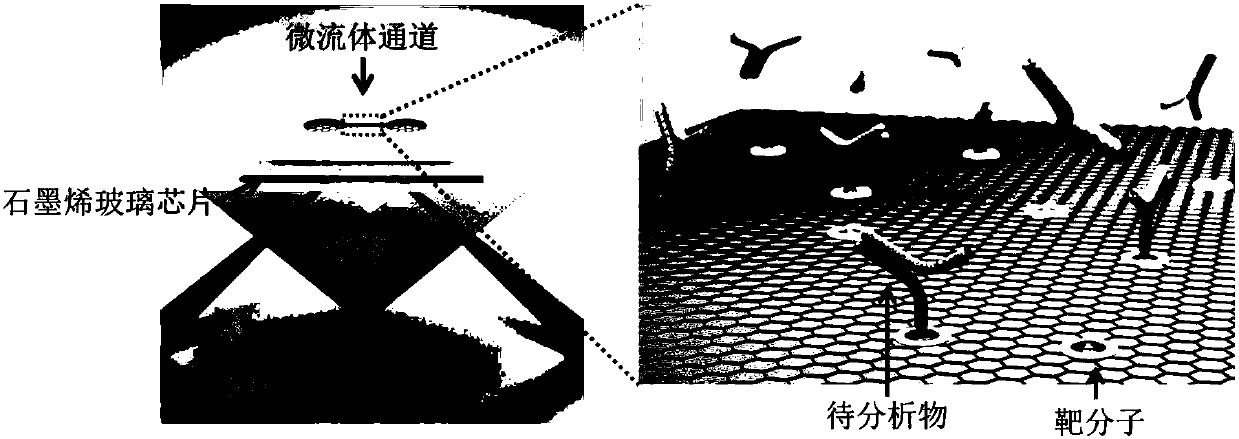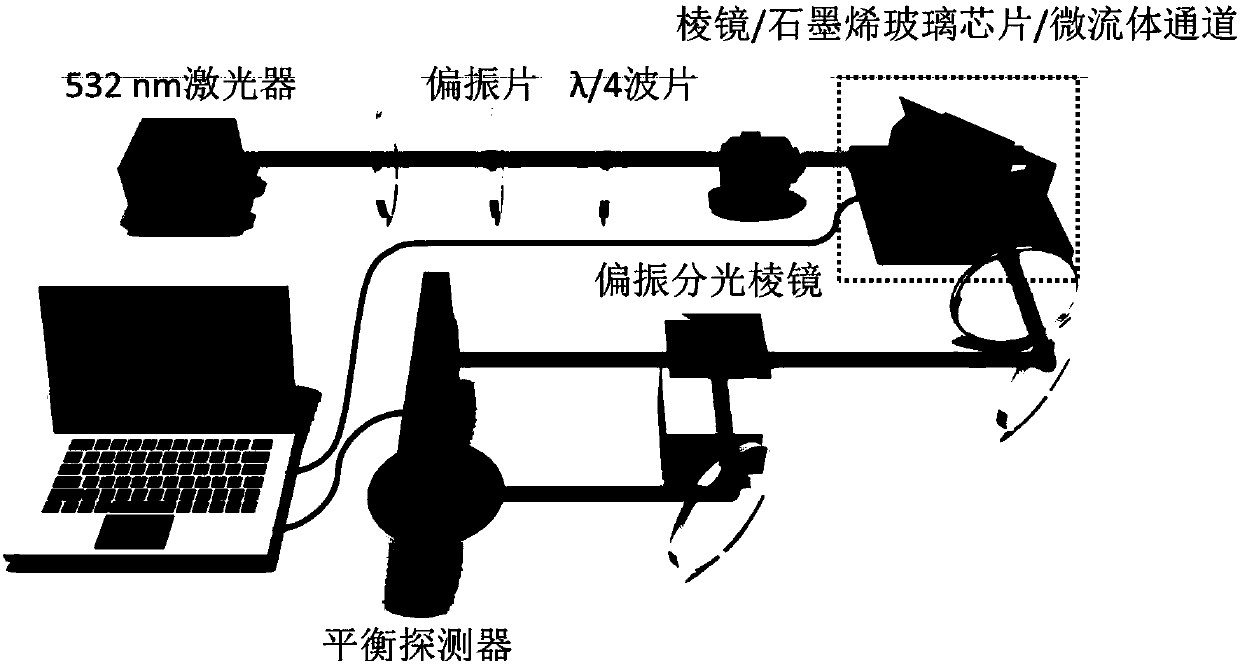A kind of preparation method of graphene glass chip
A glass chip and graphene technology, which is applied in the field of refractive index sensing and biomolecular detection, can solve the problems of weak interaction between graphene and substrate, difficulty in precisely controlling the thickness of graphene, and easy washing of graphene layers. , to achieve the effect of strong repeatability, strong binding force and long service life
- Summary
- Abstract
- Description
- Claims
- Application Information
AI Technical Summary
Problems solved by technology
Method used
Image
Examples
Embodiment 1
[0039] Embodiment 1: the preparation of graphene glass chip
[0040] On the cleaned quartz glass substrate, a graphene film with a controllable layer number is directly grown by chemical vapor deposition technology, and various biomolecules are coupled on the surface of the graphene, so as to obtain such a figure 1 The application shown is a graphene-on-glass chip for detecting interactions between biomolecules. The specific method includes the following steps:
[0041] 1) Quartz glass substrate cleaning:
[0042] Use acetone, isopropanol, and ultrapure water to ultrasonically clean a quartz glass substrate with a size of 15mm×15mm×1mm for 10 minutes, and dry it with nitrogen;
[0043] 2) Graphene growth:
[0044] The cleaned quartz glass substrate is placed in a tube furnace, the pressure of the reaction chamber is pumped to below 10Pa, and then 500-1000sccm Ar and 500-1000sccm H are introduced 2 , the temperature is raised to 1000-1100°C; after the temperature is stabilize...
Embodiment 2
[0054] Embodiment 2: the use of graphene glass chip in graphene refractive index sensor
[0055] The graphene glass chip in the present invention is specially suitable for the refractive index sensor based on the polarized absorption characteristic of graphene under the condition of total reflection. Such as figure 2 As shown, the core of this type of refractive index sensor consists of an optical system, a graphene glass chip, and a microfluidic system. The prism, the graphene glass chip, and the microfluidic channel are assembled together in a sandwich structure. Specifically, the glass substrate side of the chip is bonded to the prism with a refractive index matching liquid, and the PDMS microfluidic channel is bonded to the graphite chip. On the graphene side, biomolecules bound to the graphene surface reside in microfluidic channels. Mount the assembled prism / graphene-glass chip / microfluidic channel on an e.g. image 3 In the detection optical system shown, a 532nm la...
Embodiment 3
[0056] Embodiment 3: the sensitivity analysis of graphene glass chip
[0057] On the graphene glass chip of Example 1, rabbit IgG molecules were coupled as target molecules, and after the chip was mounted on the refractive index sensor described in Example 2, a series of concentration gradient rabbit anti- IgG solution (0.1, 0.4, 1, 2.5, 10, 25, 100μg / ml), the combination of anti-IgG and IgG on the chip causes the refractive index of the graphene surface medium to change, so that the graphene is sensitive to S polarized light and P The absorption of polarized light changes, and the signal collected by the balance detector after polarization splitting also changes accordingly. From Figure 4 It can be seen that as the concentration of anti-IgG increases, the response value of the detector increases, and the detection sensitivity of the sensor to anti-IgG is 0.1 μg / ml. Figure 5 It is the result of detecting different concentrations of anti-IgG solutions using a commercial BIA...
PUM
| Property | Measurement | Unit |
|---|---|---|
| Sensitivity | aaaaa | aaaaa |
| Sensitivity | aaaaa | aaaaa |
Abstract
Description
Claims
Application Information
 Login to View More
Login to View More - R&D
- Intellectual Property
- Life Sciences
- Materials
- Tech Scout
- Unparalleled Data Quality
- Higher Quality Content
- 60% Fewer Hallucinations
Browse by: Latest US Patents, China's latest patents, Technical Efficacy Thesaurus, Application Domain, Technology Topic, Popular Technical Reports.
© 2025 PatSnap. All rights reserved.Legal|Privacy policy|Modern Slavery Act Transparency Statement|Sitemap|About US| Contact US: help@patsnap.com



